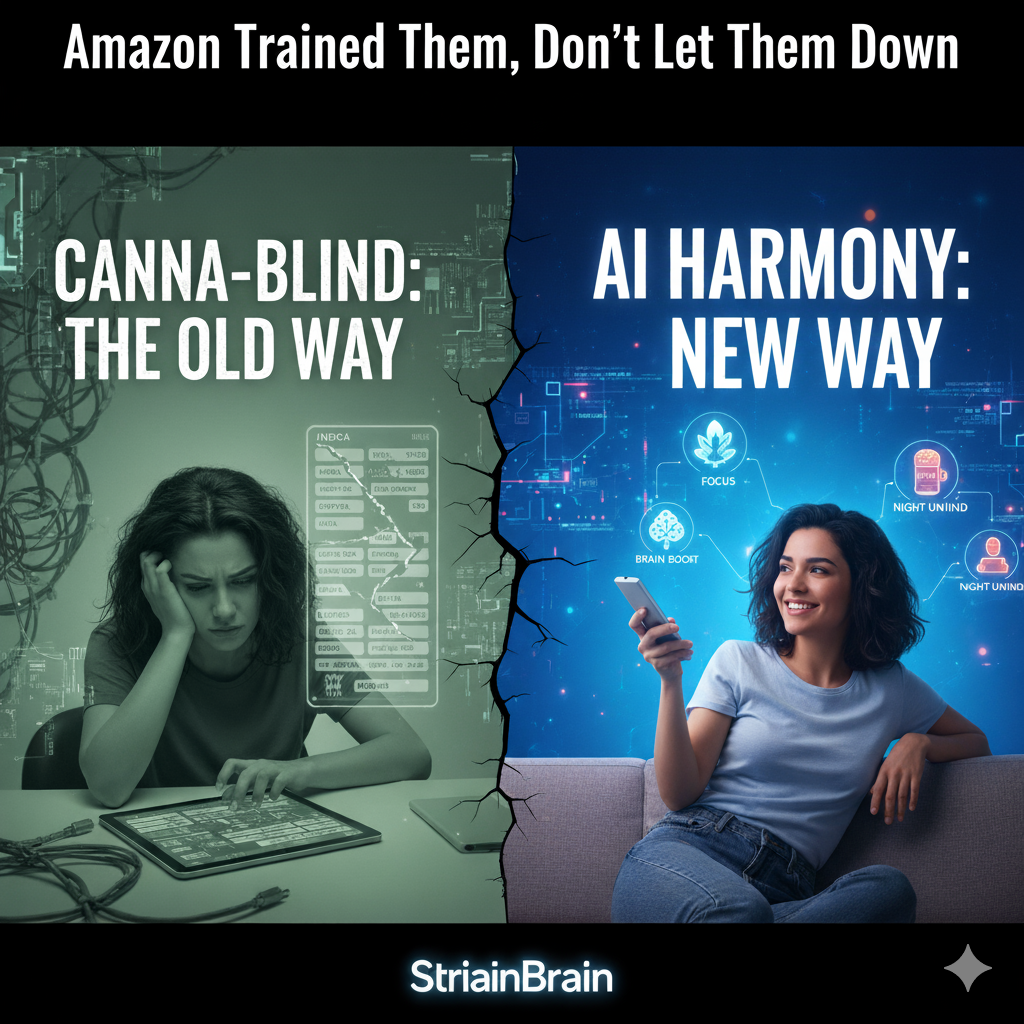Amazon Trained Them, Don't Let Them Down

Sara spilled her coffee this morning, straight onto her keyboard. Not her day, and it wasn't even 9 a.m. yet.
She's a gamer. Keyboards matter. The click. The bounce. That perfect rhythm when your fingers know exactly where to go three hours into a raid. So, she jumped on Amazon, half laughing, half swearing and typed something ridiculous "mechanical gaming keyboard high actuation speed low latency RGB hot-swappable switches wired anti-ghosting 1000Hz polling rate." Amazon understood. One showed up that afternoon.
While she waited, she flopped on the couch and hit the mic button on her Fire remote.
"I want a funny movie, but not a dumb one." Netflix nailed it. Later, she opened her restaurant app, and before she could even type, it already knew. Same order, comfort in two taps.
Tomorrow, Sara's trying cannabis for the first time. She wants something for late-night gaming sessions, focused, steady, not anxious. She'll open your dispensary's website, curious and ready. She'll type what feels natural.
"I want to focus, but not be anxious." That's where it falls apart. Instead of understanding her, the site throws back a grid of names that sound like rejected Pokémon characters. Strain names. THC percentages. Filters that mean nothing to her. No guidance. No conversation. Just noise. After a few minutes of scrolling, she closes the tab, maybe checks another shop. One that feels more like the rest of her digital world. One that listens, learns, and gets her.
The "Ah-Ha" Moment
This is how people shop now. They expect relevant, personalized experiences that make it easy to get what they want, when they want it. Almost every other industry figured this out. Cannabis? We're still handing people a digital menu and wishing them luck.
Why Amazon Feels Effortless (and Dispensaries Don't)
What makes Sara's Amazon, Netflix, and DoorDash experiences so seamless isn't magic. It's technology. Machine Learning, natural language processing, and structured data working behind the scenes. When she types that absurd keyboard query, machine learning interprets her intent.
When Netflix recommends a "funny but not dumb" movie, it uses unstructured data from millions of viewing sessions. When her restaurant app predicts her order, it's learning from behavior over time.
These aren't futuristic ideas. They're the foundation of modern commerce, though I'll admit, even saying that feels a bit dramatic. But it's true. And they're exactly what cannabis retail is missing. Sara doesn't know she's interacting with algorithms, she just knows what feels normal. When your dispensary's site can't meet that standard, it's not her expectations that are unreasonable. It's that the technology powering her digital life hasn't reached cannabis, until StrainBrain. More on that soon.
Nerding Out for a Second
A quick primer on the technologies shaping modern commerce. So when you hear these terms from tech providers, or see them pop up in other articles, you'll know what they mean and why they matter.
Unstructured Data
All the messy, human stuff: natural language, clicks, scrolls, session notes, reviews, chat phrasing. It carries intent that menus and filters miss.
What to ask your provider: How do you capture, store, and learn from unstructured inputs, not just SKU fields and THC percentages?
Machine Learning
Systems that learn from behavior over time, turning patterns into predictions, and predictions into better recommendations and UI changes.
Ask your provider: What models are training on our user behavior, and how often do they update their recommendations and interface?
Effects Taxonomy
A shared, precise vocabulary for outcomes: focus, calm, relief, sleep quality, appetite, that maps real words to real products.
Ask your provider: Do you maintain an effects taxonomy that links everyday language to specific products and doses, and can it evolve?
Large Language Model (LLM)
A powerful model that understands and generates natural language at broad scale. Great for comprehension, summarization, and rich dialogue.
Ask your provider: Where does an LLM sit in your stack, how do you constrain it to cannabis context, and how do you prevent hallucinations?
Small Language Model (SLM)
A compact, domain-tuned model that runs faster, cheaper, and closer to your data, ideal for real-time retail tasks.
Ask your provider: What SLMs do you run for on-site intent mapping, effects translation, and recommendations, and how are they fine-tuned on our data?
Why Cannabis Buyers Are Frustrated
Every time your customers interact with modern, AI-powered commerce, their idea of "normal" gets more sophisticated. What felt fine six months ago now feels old-fashioned. And what feels normal today will feel primitive six months from now.
The numbers don't lie – when cannabis retail gets smart, customers respond. When it doesn't, they leave.
The Regulatory Moat Is Cracking
For years, regulations somewhat protected cannabis retail from having to meet high customer expectations. Complicated licensing, federal prohibition, and strict compliance rules created barriers that excused less-than-stellar experiences. Customers understood they were shopping in a different world with different rules.
But as cannabis becomes more common and the market matures, customers are judging it by the same standards they use for everything else. That regulatory moat that once guarded the industry is now a problem, preventing it from adapting to what modern customers want.
The sophisticated AI technologies that power Amazon, Netflix, Spotify and the like are now available for cannabis retailers. The methods are proven. And the technology is ready. The question is, will cannabis use it?
In our next piece, we'll dive into how this intelligence revolution is changing the physical layout of cannabis retail and what that means for the future of dispensary real estate.




